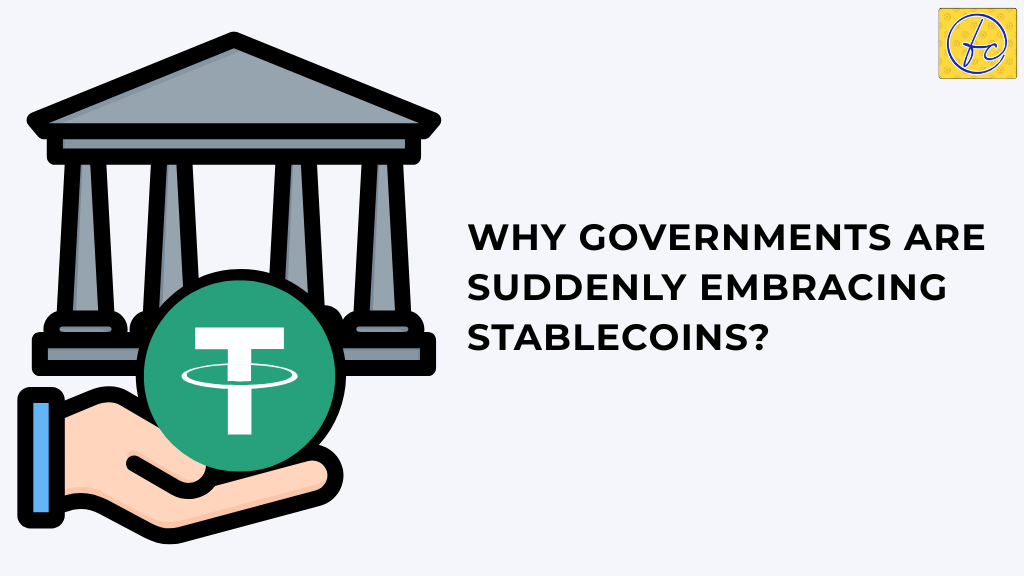
Why Governments Are Suddenly Embracing Stablecoins— The Full Story Explained
Why governments are suddenly embracing stablecoins is a question echoing across financial and political circles globally. The shift is real, rapid, and rooted in practical benefits. Governments are no longer sitting on the fence. They’re actively exploring, regulating, or even launching their own versions of stablecoins. Why? Because stablecoins combine the innovation of digital currencies with the safety and predictability of fiat money — and that’s exactly what the modern financial system needs.
This blog uncovers the real reasons behind this global shift, with concrete examples, simplified explanations, and answers to the most important questions.
What Are Stablecoins and Why Are They Important to Governments?
Stablecoins are digital currencies that are pegged to real-world assets such as the US dollar, euro, or even commodities like gold. This peg makes them relatively immune to the wild price swings seen in cryptocurrencies like Bitcoin or Ethereum.
Why governments are suddenly embracing stablecoins has a lot to do with this stability. Stablecoins allow countries to tap into the speed, transparency, and efficiency of blockchain technology without sacrificing the control and predictability they need to maintain financial order.
How Do Stablecoins Improve Financial Stability?
One of the most critical reasons why governments are suddenly embracing stablecoins is their ability to improve financial stability. Traditional cryptocurrencies are notoriously volatile, making them impractical for widespread use in everyday transactions or long-term savings.
Stablecoins, on the other hand, offer a predictable store of value and unit of account. They help governments modernize payment systems without introducing financial chaos. For instance, countries like Japan and Switzerland have studied stablecoin frameworks that allow innovation without threatening monetary equilibrium.
Can Stablecoins Boost Financial Inclusion?
A huge portion of the global population remains unbanked or underbanked. In regions where banking infrastructure is weak, stablecoins accessed via mobile devices can provide a critical lifeline.
Why governments are suddenly embracing stablecoins also ties to financial inclusion. The Bahamas launched its Sand Dollar to ensure island residents, even in remote areas, could participate in the digital economy. Similarly, Nigeria’s eNaira aims to bring millions of unbanked citizens into the formal financial system.
Are Stablecoins a Game-Changer for Cross-Border Payments?
Cross-border payments are expensive, slow, and full of intermediaries. In contrast, stablecoins offer near-instant transactions at a fraction of the cost. That’s one of the most compelling reasons why governments are suddenly embracing stablecoins.
For example, the Monetary Authority of Singapore has collaborated with other nations to pilot cross-border stablecoin settlements, reducing transaction times from days to seconds.
How Do Stablecoins Support Better Monetary Control?
One of the major concerns with traditional cryptocurrencies is the lack of government oversight. With stablecoins — especially those issued or approved by central banks — governments can track transactions, control money supply, and enforce anti-money laundering regulations.
This is a central reason why governments are suddenly embracing stablecoins: they offer a regulated digital currency model that supports, not threatens, national interests. China’s Digital Yuan gives the government full visibility into money flows, making it a powerful tool for economic policy.
Are Governments Responding to the Rise of Private Stablecoins?
Yes, and urgently. The rapid adoption of private stablecoins like Tether (USDT) and USD Coin (USDC) has made governments realize the need to act fast or risk losing monetary sovereignty.
Why governments are suddenly embracing stablecoins also stems from a competitive need. By issuing their own stablecoins or tightly regulating private ones, governments can maintain control over their economies and avoid reliance on foreign or private digital money systems.
How Do Stablecoins Increase Transparency and Security?
Blockchain-based stablecoins come with built-in transparency. Every transaction is traceable and immutable, making it easier for governments to detect fraud, money laundering, and tax evasion.
Why governments are suddenly embracing stablecoins is also about trust. With proper regulation, stablecoins can deliver both transparency and security, making them a reliable component of modern finance. Singapore and the UK are already developing regulatory frameworks to encourage safe usage.
What Challenges Do Governments Face With Stablecoins?
While there are clear benefits, the road ahead is not without hurdles.
Some key challenges include:
- Designing clear regulations without stifling innovation
- Managing citizen privacy while maintaining control
- Ensuring technological infrastructure can support adoption
- Coordinating globally to avoid fragmented systems
Why governments are suddenly embracing stablecoins despite these issues shows their recognition of the long-term benefits. Many are opting for pilot programs and phased rollouts to address these challenges carefully.
What Does the Future Look Like for Government-Backed Stablecoins?
The trend is clear — the future of money is digital, and stablecoins are playing a leading role. As more governments roll out their Central Bank Digital Currencies (CBDCs), we can expect:
- Faster domestic and international transactions
- Lower transaction fees for consumers
- Improved ability to implement monetary policy
- Greater financial inclusion
Why governments are suddenly embracing stablecoins today is laying the foundation for a radically more efficient and inclusive financial world tomorrow.
Frequently Asked Questions (FAQs)
1. What exactly are stablecoins?
Stablecoins are cryptocurrencies that are backed by stable assets like fiat currencies or gold, offering price stability.
2. Why are governments focusing on stablecoins instead of other cryptocurrencies?
Because stablecoins provide the benefits of digital assets without the extreme volatility of traditional cryptocurrencies.
3. Are all stablecoins issued by governments?
No. Some are private (like USDC or Tether), while others are government-issued (like CBDCs such as China’s Digital Yuan or Nigeria’s eNaira).
4. How do stablecoins affect international trade and remittances?
They make cross-border payments faster and cheaper, helping both businesses and individuals.
5. Is the adoption of stablecoins safe for ordinary citizens?
Yes, especially when regulated or issued by central banks. However, citizens should stay informed and only use trustworthy platforms.
DISCLAIMER
The views, thoughts, and opinions expressed in this article belong solely to the author, and should not be taken as investment advice. Do your own research before taking any investment decisions.

